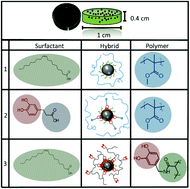The surface chemistry of iron oxide nanocrystals: surface reduction of γ-Fe2O3 to Fe3O4 by redox-active catechol surface ligands
Abstract
The effect of surface functionalization on the structural and magnetic properties of catechol-functionalized iron oxide magnetic (γ-Fe2O3) nanocrystals was investigated. γ-Fe2O3 nanocrystals (NCs) were synthesized from iron acetyl acetonate in phenyl ether with 1,2-tetradecanediol, oleic acid, and oleylamine. X-ray powder diffraction in combination with Mössbauer spectroscopy revealed the presence of γ-Fe2O3 (maghemite) particles only. Replacement of oleic acid (OA) with catechol-type 3,4-dihydroxyhydrocinnamic acid (DHCA) or polydentate polydopamine acrylate (PDAm) surface ligands leads to a pronounced change of the magnetic behavior of the γ-Fe2O3 nanocrystals and separated them into two distinctive magnetic entities. XPS and Mössbauer spectroscopy revealed the shell to be reduced with a magnetite (Fe3O4) contribution of up to 33% of the total mass while the core remained maghemite (γ-Fe2O3). The magnetic interaction between the maghemite core and the magnetite shell strongly reduced the anisotropy constant of the nanocrystals and the effective magnetization. Our experiments show that the surface chemistry strongly affects the phase distribution and the macroscopic magnetic properties of iron oxide nanopowders.



 Please wait while we load your content...
Please wait while we load your content...